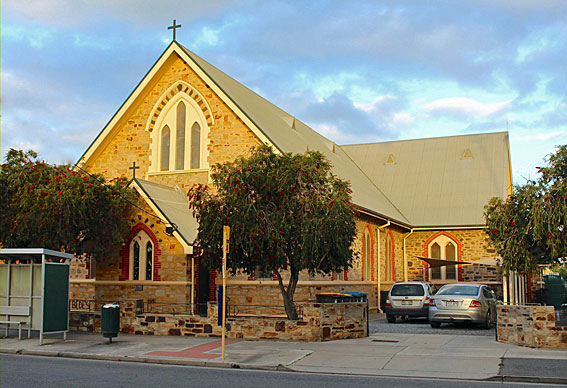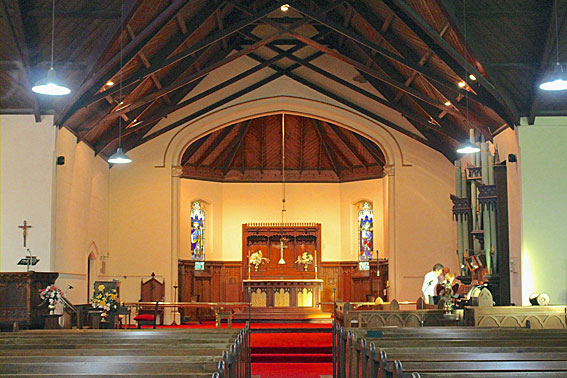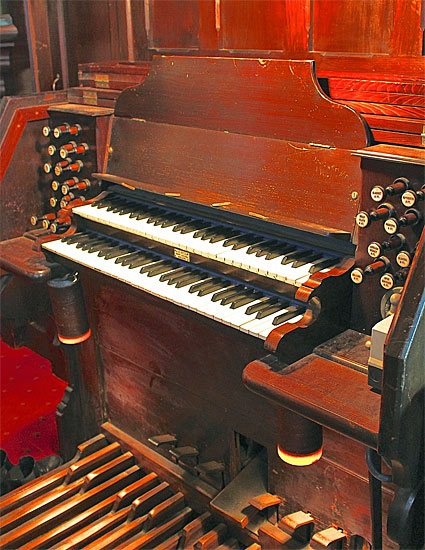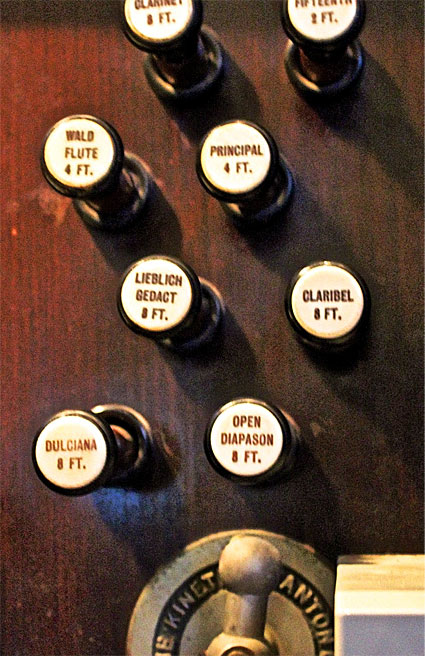
St Bede's Anglican Church, Semaphore: exterior
[Photograph by Trevor Bunning (1 October 2013)]

St Bede's Anglican Church, Semaphore: exterior
[Photograph by Trevor Bunning (1 October 2013)]
Historical and Technical Documentation by David Shield
© OHTA 2013 (last updated September 2013)
The current building replaces the original structure built in 1879 and an extension of 1885. In the 1930s St Bede's was regarded as one of the most imposing church buildings of the district. The church had been extended with the growth of the congregation and a fine pipe organ had been procured. Apart from changes in motive power of the wind it remains in substantially original condition.
Until 1878 Anglicans living on Le Fevre Peninsula attended St Paul's at Port Adelaide. In June of that year services began at Semaphore in the large room of Mr Randford's house near the beach.1 The foundation stone for a new church was laid on 26 October. Planned by Mr J.O. Lovely with Messrs Williams and Cleave as contractors it was to cost £1050 and be of Gothic design. Seating 300 persons:
…The walls will be 18 feet high, surmounted by a gable roof. …The chancel is 15 x 12, and there is a vestry 10 x 9.6. The porch is 10 x 6, and is provided with a door on the north and south sides. The whole of the exposed woodwork inside the building will be Huon pine varnished. The roof will be of open woodwork, the panels between the main rafters being diagonally bordered.2
By 1883 the need for greater accommodation was felt and the vestry decided to erect a new church to seat 500 persons on the southern side of the old building. Plans were prepared by John Haslam to be erected immediately.3 However the new church did not eventuate, instead the chancel was moved back 20 feet, the additions being completed in iron and wood being completed in August 1885.4
Further extension in 1899 saw the removal of the previous work and the addition of a stone transept and an organ chamber.5 It was noted in the press that the authorities were negotiating with J.E. Dodd for the purchase of a two-manual instrument with 16 speaking stops.6 Finances must have been tight and to ensure the order Dodd made special arrangements with St Bede's for the payment of its tuning. In a letter to Mr Bronir of St Georges Church Goodwood in 1905 Dodd wrote:
Re the St. Bede's Church, Semaphore, tuning rate. When this Church was negotiating with me, for the purchase of a pipe organ, the question of tuning was introduced. My charge for tuning the organ was £15:15:0, but as the Wardens explained that the Church was not in a financial position to warrant this expenditure at the time, I agreed on condition that the order was placed with me, to allow them a rebate off the first year's A/c of £7:7:0, off the second year £5:5:0 & off the third year £3:3:0. Last year saw the expiration of our agreement, & this Church is now paying the full rate, of Fifteen guineas. This was reiterated in a letter to W.H. Shaw of St Bede's in September 1908.7

St Bede's Anglican Church, Semaphore: interior
[Photograph by Trevor Bunning (1 October 2013)]
The organ built by J.E. Dodd was dedicated in October 1901.8 The Cornopean was prepared for in the original specification but was not to be added until 1908.9 A hydraulic engine, since replaced, provided the wind and may still be seen. Apart from slight differences in stop names the organ appears to be in substantially original condition.

St Bede's Anglican Church, Semaphore: organ
[Photograph by Trevor Bunning (1 October 2013)]
| GREAT Open Diapason Claribel Lieblich Gedact Dulciana Principal Wald Flute Fifteenth Clarinet Swell to Great SWELL Lieblich Gedact Geigen Principal Hohl Flute Viol d'Orchestra Octave Flauto Traverso Cornopean Oboe PEDAL Open Diapason Lieblich Bourdon Great to Pedal Swell to Pedal |
8 8 8 8 4 4 2 8 16 8 8 8 4 4 8 8 16 16 |
(TC) 'clarionette' 'lieblich bourdon' 'geigen principal' (no 11 TC to CC) 'super octave' (added 1908 Dodd) 'Bourdon' |
Compass 56/30
Trigger tremulant
3 composition pedals to Great
3 composition pedals to Swell
Balanced swell pedal
Attached drawknob console
1 Register 28/10/1878 p.6
2 ibid
3 Register 11/6/1884 p.5
4 Register 6/8/1885 p.6
5 Advertiser 18/9/1899 p.7
6 Register 18/9/1899 p.6
7 DLB vol 4 1903-1909 C. Bronir Esq., Warden of St George's Church, 9th. August, 1905. p.378, ibid W.H. Shaw Esq., 16th. September, 1908 p.561-562
8 The stops of the organ were given as follows: — Great Organ — 1, open diapason (8); 2, claribel (8); 3, dulciana (8); 4, principal (4); 5, Wald flute (4); 6, clarionette (8); 7, Leiblich Gedacht (8); 8, fifteenth (2). Swell Organ — 1, Leiblich Bourdon (16); 2, Geigan principal (8); 3, Hohl flute (8); 4, viole d'orchestre (8); 5, super octave (4); 6, flauto traverso (4); 7, oboe (8); 8, cornopean (prepared). Pedal Organ— 1, open diapason (16); 2, Bourdon (16); 3, couplers, and six composition pedals, with a tremulant pedal. Register 2/10/1901 p.5
9 Register 29/7/1908 p.4

St Bede's Anglican Church, Semaphore: console
[Photograph by Trevor Bunning (1 October 2013)]

St Bede's Anglican Church, Semaphore: detail of right-hand stop jamb
and Kinetic-Swanton hydraulic tap
[Photograph by Trevor Bunning (1 October 2013)]